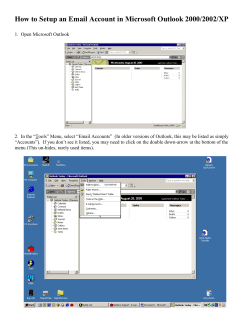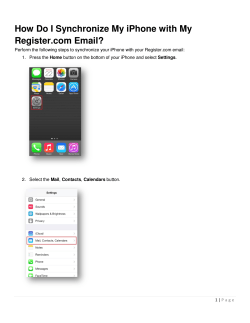
Document 363246
E-‐mail Quick Start using Outlook Web Application (OWA) Signing In • • • • 1 Point your browser to: email.fhda.edu Select either private or public computer. If you are the only person who has access to the computer it is private. With the private version, the system will allow a longer period of inactivity before signing you out. Leave the box next to “Use the light version…” unchecked unless you are visually impaired or are using a very old version of your browser. Enter your 8-‐digit Campus Wide ID (CWID) and the password you use to sign into MyPortal. Some basics: 1. E-‐mail and calendar are completely integrated. A meeting invitation will generate an e-‐ mail that appears in your inbox and displays on your calendar. 2. Right clicking (Control click on a Mac) will often display a menu that contains the action you are looking for. 3. Moving your mouse over an icon will display the icon’s function. 4. Icons without a down-‐arrow next to them do only one thing. There is no drop-‐down menu. 5. Clicking on an icon or title can produce something different than when you click on the down arrow next to it. For example clicking on New in the menu bar will bring up the form to create a new e-‐mail. However clicking on the down arrow to its right will display a list of options. 6. Arrows pointing to the right are used to expand and collapse lists. In the example to the right, the solid arrow shows that Ann Beebe’s list of files is expanded, but the Inbox folder is collapsed. 7. Always click the Save button, when you have entered some text in an e-‐mail, contact or appointment. 8. Don’t be afraid to try something, you can’t break it. Try opening one of the Help videos in a separate browser “?” to window and follow along. The User Guides and videos can be found at: http://ets.fhda.edu/getting-help/email/index.html or click on the view the online help. 9. Clicking on the Address Book will display the district address book with all contact information and meeting rooms. Entering a name in “Find Someone” next to it, will allow you search for a specific person. 10. Use the following key combinations to Copy – Ctrl C, to Cut – Ctrl X, and to Paste – Ctrl V. They can be used with Text or e-‐mail addresses. ETS: Foothill – De Anza CC District October 24, 2014 E-‐mail Quick Start using Outlook Web Application (OWA) The e-mail screen: 2 Actions Menu ETS: Foothill – De Anza CC District October 24, 2014 E-‐mail Quick Start using Outlook Web Application (OWA) 3 ETS: Foothill – De Anza CC District October 24, 2014 E-‐mail Quick Start using Outlook Web Application (OWA) New Message Forms • • • • • • Icons at the top of the form are explained in the table to the right. Type in part of the name and click the “Check Names” icon at the top of the screen. A list of matches will display for you to select from. Another option is to click on To… or Cc… to open the address books. To add a signature, go to the main screen, click on Options/See All Options/Settings/Mail. To get to Bcc, click on To or Cc and you will see the field at the bottom of the screen. Use Options to determine if you want Bcc displayed. Button Send Description Sends the message to the recipients. Saves the message in the Drafts folder but doesn't send the message. Attaches a file to the message. For more information about how to attach files, see Working with Attachments. Insert a picture into the message When entering several e-‐mail addresses, they are separated by a “;” (semicolon). Opens the Address Book to look up recipient names. Checks the names of the message recipients in the Address Book or in your Contacts folder. This can be used in place of opening the district address book. Sets the importance of the message to High. Used to print message. Appears on received and sent messages only. Sets the importance of the message to Low. Replying & Forwarding Messages • • • Right-‐click on the item in the inbox or Use purple and blue arrows at top of preview reading panel or message or Select from Action Menu in reading panel. Adds a signature at the end of the message. For more information about signatures, see Add a Signature. You have to create a signature before this button will do anything. Checks spelling in the text of the message. For more information about how to check spelling, see Learn About Spelling. FireFox uses context Spell Checking* Displays the Message Options dialog box. For more information Options about message options, see Set Message Options. Sets the format of the message to HTML or Plain text. For more * FireFox browsers have a built in Spell-‐checker. It must be turned on to function. Message information about how to set format, see Format Format l ist If as you type. If misspelled words are not underlined in red and a right click does Messages. not provide a list of correctly spelled words, do the following: Go to the browser menu Tools/Options/Advanced and select the General tab. Under Browsing, check the last box – “Check my spelling as I type”. ETS: Foothill – De Anza CC District October 24, 2014 4 E-‐mail Quick Start using Outlook Web Application (OWA) Folders • • • • • • 5 Folders are always displayed on left side of the screen. The content of a folder is listed to the right when the folder is highlighted. You can set the Reading Panel for each folder using the drop-‐down View menu. Use Collapse/Expand buttons to the left of any item with sub-‐items or sub-‐folders To add a sub-‐folder, highlight the main folder and Right-‐click (Control-‐click on a Mac). Select Create New Folder. You will then see the folder and able to name it. The right-‐click pop-‐up menu allows you to do all sorts of things with your folders. Folder Right-‐click Menu Right-‐click menu when item in folder is highlighted. ETS: Foothill – De Anza CC District October 24, 2014 E-‐mail Quick Start using Outlook Web Application (OWA) Lessons Learned Now that we’ve had several weeks to work with OWA, we have discovered several things that will make your move to OWA a little easier: • The four most powerful tips: 1. Right-‐click to display contextual menus (read page 1 of this document). 2. Mouse Over to display icon description (again page 1 of this document). 3. Expanded • • • • and Collapsed folders indicated by black and clear arrows (again page 1 of this document). 4. Check Names to find an address in both district directory and your personal contacts (page 4 of this document). Internet Explorer (IE) on a PC provides all of the OWA features such as a view of a contact’s schedule in the address book. Everyone who was converted before July (that is everyone except Faculty) will run into the Delivery Failure problem. Read the handout and or FAQ (E-‐mail #33) to learn how to handle it. Rather than pasting e-‐mail addresses from Eudora/Thunderbird, etc. directly into a message, create a group and paste them into the Members box and click on Add to Group button. See page 5 of the Contacts Quick Start Guide for information on creating groups. Pasting directly into a message can lead to unpredictable results. When entering several e-‐mail addresses, they are separated by a “;” (semicolon). The backspace key on the keyboard can also be used to enter a “;”. ETS: Foothill – De Anza CC District October 24, 2014 6
© Copyright 2025












